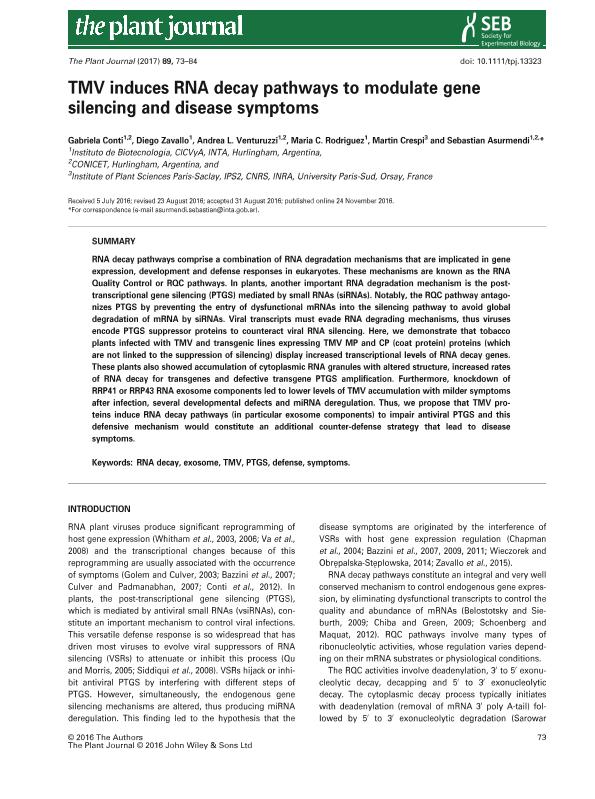Artículo
TMV induces RNA decay pathways to modulate gene silencing and disease symptoms
Conti, Gabriela ; Zavallo, Diego
; Zavallo, Diego ; Venturuzzi, Andrea Laura
; Venturuzzi, Andrea Laura ; Rodriguez, Maria Cecilia
; Rodriguez, Maria Cecilia ; Crespi, Martin; Asurmendi, Sebastian
; Crespi, Martin; Asurmendi, Sebastian
 ; Zavallo, Diego
; Zavallo, Diego ; Venturuzzi, Andrea Laura
; Venturuzzi, Andrea Laura ; Rodriguez, Maria Cecilia
; Rodriguez, Maria Cecilia ; Crespi, Martin; Asurmendi, Sebastian
; Crespi, Martin; Asurmendi, Sebastian
Fecha de publicación:
01/2017
Editorial:
Wiley Blackwell Publishing, Inc
Revista:
Plant Journal
ISSN:
0960-7412
Idioma:
Inglés
Tipo de recurso:
Artículo publicado
Clasificación temática:
Resumen
RNA decay pathways comprise a combination of RNA degradation mechanisms that are implicated in gene expression, development and defense responses in eukaryotes. These mechanisms are known as the RNA Quality Control or RQC pathways. In plants, another important RNA degradation mechanism is the post-transcriptional gene silencing (PTGS) mediated by small RNAs (siRNAs). Notably, the RQC pathway antagonizes PTGS by preventing the entry of dysfunctional mRNAs into the silencing pathway to avoid global degradation of mRNA by siRNAs. Viral transcripts must evade RNA degrading mechanisms, thus viruses encode PTGS suppressor proteins to counteract viral RNA silencing. Here, we demonstrate that tobacco plants infected with TMV and transgenic lines expressing TMV MP and CP (coat protein) proteins (which are not linked to the suppression of silencing) display increased transcriptional levels of RNA decay genes. These plants also showed accumulation of cytoplasmic RNA granules with altered structure, increased rates of RNA decay for transgenes and defective transgene PTGS amplification. Furthermore, knockdown of RRP41 or RRP43 RNA exosome components led to lower levels of TMV accumulation with milder symptoms after infection, several developmental defects and miRNA deregulation. Thus, we propose that TMV proteins induce RNA decay pathways (in particular exosome components) to impair antiviral PTGS and this defensive mechanism would constitute an additional counter-defense strategy that lead to disease symptoms.
Palabras clave:
Defense
,
Exosome
,
Ptgs
,
Rna Decay
,
Symptoms
,
Tmv
Archivos asociados
Licencia
Identificadores
Colecciones
Articulos(SEDE CENTRAL)
Articulos de SEDE CENTRAL
Articulos de SEDE CENTRAL
Citación
Conti, Gabriela; Zavallo, Diego; Venturuzzi, Andrea Laura; Rodriguez, Maria Cecilia; Crespi, Martin; et al.; TMV induces RNA decay pathways to modulate gene silencing and disease symptoms; Wiley Blackwell Publishing, Inc; Plant Journal; 89; 1; 1-2017; 73-84
Compartir
Altmétricas



